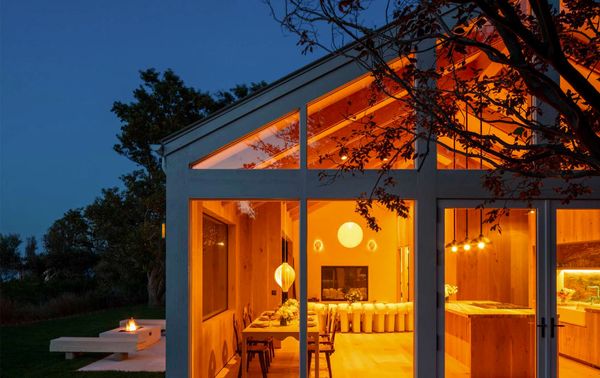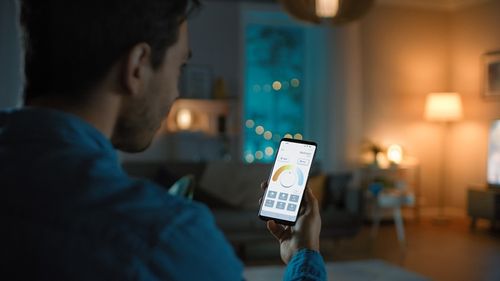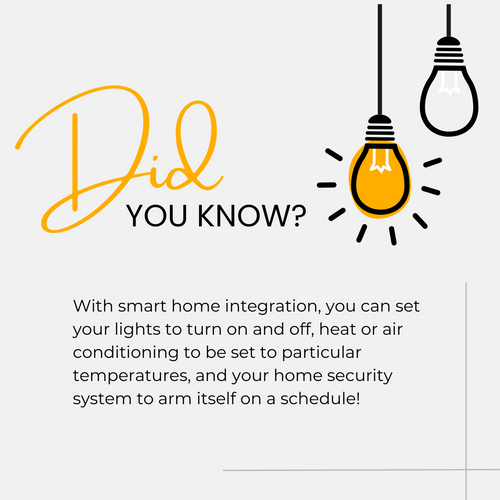
At a Glance:
Importance of Lighting in Interior Design
The Science of Circadian Lighting
Seeking Professional Lighting Solutions
Lighting is the unsung hero of interior design. It's an element that can make or break the overall ambiance of a home. The way your space is lit can affect everything from your mood to your productivity, not to mention how your interior design looks at different times of the day. This article is here to shine a light on the topic of lighting, specifically focusing on the types of lighting and how they can be used effectively in your home.
Explore Home Lighting Control
Create the perfect ambiance for any occasion at home. Smart lighting offers convenience and adaptability, whether you want to light up a party or dim your home for bedtime.
Intelligent LightingImportance of Lighting in Interior Design
Lighting plays a pivotal role in setting the tone of a room. It highlights architectural features, showcases your decor, and can even alter the perceived size of a room. But beyond aesthetics, lighting also has a functional role. It illuminates our homes, making it possible for us to see and do things, especially after dark.
Understanding the types of lighting is key to creating a well-lit, inviting, and functional space. Each type serves a specific purpose and can contribute to the overall look and feel of a room. Hence, knowing how to use each type effectively can truly transform your living space.
Type of Lighting Options

Types of lighting can dramatically influence the mood, functionality, and aesthetic appeal of a space. From creating a cozy ambiance to spotlighting an exquisite piece of art, different lighting types serve unique purposes. Let's delve into the world of lighting and its diverse types.
Ambient Lighting: Setting the Scene
Often referred to as general lighting, ambient lighting casts a consistent level of illumination across a room, setting its overall mood. It's akin to the sun's natural light, enveloping the space without focusing on any specific area. You'll typically find this lighting from ceiling-mounted fixtures, wall sconces, floor lamps, or hanging chandeliers.
Task Lighting: Precision and Functionality
Designed to assist with specific tasks like reading or cooking, task lighting provides focused light where most required. The aim is to position it strategically to maximize benefits without causing glare or unnecessary shadows. Think desk lamps, under-cabinet kitchen lights, or vanity lights in the bathroom.
Accent Lighting: Highlighting the Highlights
Accent lighting brings attention to a room’s standout features. Whether it's a stunning piece of artwork or architectural details, this lighting type adds depth and dimension. Common sources include track lights, picture lights, or wall-mounted fixtures.
Natural Lighting: Embracing the Sun's Glow
An irreplaceable component of any lighting plan, natural lighting stems from the sun’s rays. Its impact goes beyond aesthetics, boosting mood and productivity while offering true-to-life color rendering. Incorporate it through windows, skylights, or light tubes that funnel sunlight directly into your home.
The Perfect Home Lighting Blend
The best lighting for homes is a harmonious blend of all four types of lighting. Ambient lighting for a pleasing overall glow, task lighting for specific activities, accent lighting to showcase special features, and natural lighting to infuse warmth and brightness. This combination will ensure your home's lighting is both functional and beautiful.
Creative Lighting Strategies
The Art of Layering Lights
Layering various types of lighting can result in a versatile and well-rounded lighting scheme. This involves the strategic combination of ambient, task, accent, and natural light to create an inviting and functional space for all times of day.
To achieve a balanced lighting scheme, begin with your general, ambient lighting. Then, identify areas requiring task lighting for specific activities. Incorporate accent lights to emphasize architectural features or artwork, and optimize natural light wherever possible.
Room-Specific Lighting
Living Room
The living room, illuminated with a blend of ambient, task, and accent lighting, exudes a warm and welcoming atmosphere. Achieve this by integrating ceiling lights, table lamps, and wall sconces.
Kitchen
The kitchen necessitates ample task lighting for food preparation areas. This can be achieved through under-cabinet lighting complemented by ambient light from ceiling fixtures.
Bedroom
In the bedroom, a combination of ambient lighting and task lighting for reading is ideal. Accent lights can further enhance the room by highlighting artwork or other features.
Home Office
A home office requires abundant task lighting for work areas, supplemented by ambient light to minimize eye strain. Natural light is also beneficial as it enhances mood and productivity.
Bathroom
In the bathroom, task lighting is crucial for the mirror area, while ambient light can establish a calming, spa-like atmosphere.
Diverse Light Fixtures
Pendant Lights
Pendant lights, hanging from the ceiling, are capable of providing both ambient and task lighting. These are commonly used over kitchen islands or dining tables.
Chandeliers
Chandeliers offer a robust source of ambient light and act as a decorative centerpiece. They're typically found in dining rooms, entryways, and expansive living spaces.
Wall Sconces
Wall sconces provide ambient or accent lighting, perfect for emphasizing architectural features or artwork.
Recessed Lights
Recessed lights, fitted into the ceiling, offer a sleek look. They can deliver ambient, task, or accent light depending on their location and the types of light bulbs used.
Floor and Table Lamps
Floor and table lamps are adaptable fixtures capable of providing ambient, task, or accent light. Their portability allows for easy adjustments to your lighting as required.
The Science of Circadian Lighting

What is Circadian Lighting?
Circadian lighting is an emerging trend in home design that replicates the sun's daily light cycle with artificial light sources. This approach aims to synchronize our indoor lighting environment with the sun's natural patterns, thereby enhancing our overall well-being. The benefits of circadian lighting, including improved sleep, mood enhancement, and productivity boosts, are becoming increasingly recognized, leading to a surge in its popularity among homeowners.
The Role of Circadian Rhythm
Our body's internal clock or circadian rhythm, which governs various physiological processes such as sleep-wake cycles and hormone release, is heavily influenced by light patterns. Misaligned exposure to different types of lighting can disrupt this rhythm. For example, bright, blue-rich light in the evening can disturb sleep, while insufficient exposure to bright light during the day may result in lethargy and low mood. Circadian lighting offers a solution to these issues by aligning our indoor lighting with our body's natural rhythms.
Light's Impact on Mood and Health
Light, specifically its intensity and color temperature, plays a significant role in our psychological and physiological states. Research indicates that bright, blue-enriched light can enhance alertness and cognitive performance, making it suitable for daytime use. Conversely, warmer, dimmer light aids relaxation and sleep readiness, ideal for evenings.
Chronic disruption of the circadian rhythm due to inappropriate lighting conditions can lead to health problems like sleep disorders, depression, and certain cancers. This highlights the need for lighting solutions like circadian lighting, which support our body's natural rhythms rather than disrupt them.
Implementing Circadian Lighting at Home
Implementing circadian lighting in residential spaces involves more than just installing a new type of light bulb. It requires a thoughtful and strategic approach to lighting design. The goal is to create a lighting environment that changes in intensity and color temperature throughout the day, mirroring the sun's natural pattern.
Seeking Professional Lighting Solutions
When it comes to creating the perfect lighting environment, professional expertise can make all the difference. Lighting design is both an art and a science, requiring a deep understanding of how light interacts with space, color, and texture. It also requires knowledge of the latest lighting technologies and how to integrate them into a cohesive design.
Professional lighting designers can help homeowners navigate the complexities of lighting design, providing guidance on everything from fixture selection to placement and control. They can also provide valuable insights into the latest trends and innovations in the world of lighting, including the growing field of circadian lighting.
For those seeking sophisticated and well-designed residential lighting solutions, consider reaching out to a professional lighting design service. With their expertise and experience, they can transform your home into a beautifully lit space that not only looks great but also supports your health and well-being.
Conclusion
Lighting plays a crucial role in creating comfortable, functional, and aesthetically pleasing living spaces. But as we've seen, it also has profound effects on our health and well-being. From regulating our circadian rhythm to influencing our mood and cognitive performance, the impact of light on our lives is far-reaching.
Circadian lighting, with its focus on aligning indoor light with the sun's natural patterns, offers a promising solution for enhancing our living environments and promoting better health. Meanwhile, professional lighting design services can provide the expertise needed to implement effective and aesthetically pleasing lighting solutions.
As you plan your next home improvement project, consider exploring the various lighting options available. Whether it's integrating circadian lighting or working with a professional lighting designer, the right lighting choices can transform your home into a space that's not only beautiful but also supports your overall well-being.
Types of Lighting FAQs

1. What is Circadian lighting?
Circadian lighting is an innovative concept that mirrors the human circadian rhythm, which is essentially a 24-hour internal clock controlled by the hypothalamus in our brain. This type of lighting aims to have a biological impact on the human circadian system. It sends signals to synchronize our sleep/wake cycle with the natural light/dark cycle. Interestingly, the circadian system is maximally sensitive to short-wavelength (blue) light, while the visual system responds better to longer wavelength light.
2. How does Circadian Lighting work?
Circadian lighting imitates the natural progression of sunlight throughout the day. It employs different tones of white light to simulate the varying color temperatures of the sun from morning till night. This light mimicking can aid in regulating our body's internal clock, enhancing mood, productivity, and sleep quality.
3. What are the benefits of Circadian Lighting?
Circadian lighting can help align our biological clock with the solar day, thereby promoting better sleep, improving mood, and boosting overall health and well-being.
4. What type of lighting is best for home?
The best type of lighting for your home depends on the room and its function. For instance, warm lighting is suitable for living rooms and bedrooms for a cozy ambiance, whereas bright, cool white light is ideal for task-oriented spaces like the kitchen or home office.
5. What is the most efficient indoor lighting?
LED lights are currently the most energy-efficient indoor lighting option. They use significantly less electricity than conventional incandescent bulbs, have a longer lifespan, and come in a variety of color temperatures.
6. How can I implement Circadian Lighting in my home?
You can achieve circadian lighting in your home by using smart light bulbs or fixtures that can adjust color temperature and brightness throughout the day. Some systems can even be automated to match the natural light cycle of your local area.
7. Is Circadian Lighting expensive?
While the initial cost of circadian lighting systems can be higher than conventional lighting, they often prove to be cost-effective in the long run due to their energy efficiency and longevity.
8. Can Circadian Lighting help with Seasonal Affective Disorder (SAD)?
Yes, research has shown that exposure to certain types of light can alleviate symptoms of SAD, a type of depression that's related to changes in seasons. Circadian lighting, which mimics natural sunlight, can be beneficial in managing this disorder.
9. Can all LED lights provide Circadian Lighting?
Not all LED lights can offer circadian lighting. For this, you need tunable or human-centric LED lights that can change color temperature and intensity throughout the day.
10. Are there any potential downsides to Circadian Lighting?
While the benefits of circadian lighting are numerous, it's important to note that everyone's internal clock is unique. Therefore, what works for one person may not work for another. It's always recommended to consult with a lighting professional or healthcare provider to determine the best lighting solution for your specific needs.
Why Trust Logic Integration?
Logic Integration is a Colorado-based custom integrator, offering a wide range of AV and automation services, for both residential and commercial settings. We partner with leading technology brands to provide you with the latest and most reliable solutions. We’ll collaborate closely with you to understand your needs and preferences, crafting a user-friendly system that complements your space and lifestyle. Our commitment to clean installations ensures all technology blends seamlessly with your environment, minimizing clutter and maximizing aesthetics. At Logic AV, we believe that technology integration is an ongoing process. This is why we offer comprehensive maintenance and support services to ensure any system we install continues to function flawlessly for years to come.
Our team is comprised of experienced, certified professionals with deep technical knowledge and a passion for innovative solutions. Named CTA’s Integrator of the Year, we are fully accredited by organizations such as the Custom Electronic Design & Installation Association, Home Technology Association, and National Association of Home Builders. Ultimately, choosing Logic Integration means trusting your AV and automation needs to a proven, experienced, and customer-focused company. We'll transform your space into a connected, intelligent environment that elevates your everyday life.
Technology Solutions by Logic Integration
As a rapidly developing technology and integration firm, we keep ourselves up-to-date with the latest products, technologies, and industry trends. As a result, our technical team is the most well-trained in the industry, enabling us to effectively improve our clients' communication and entertainment needs. At Logic Integration, we place great emphasis on the quality of audio and visual products as well as our quick response times to service and sales communication. Our experienced technicians are well-versed in the correct installation of smart home products, video solutions, home theater options, and more. Visit us in person or call us at 303-484-8237 to learn more.